Image Source : Wiki Commons
Future archaeologists might consider going to the Moon to excavate the lunar surface for the remains of past lunar missions.
The lunar surface is strewn with hundreds of items, from spacecraft, containers of urine, flags, footprints, personal items and finally plaques.
So how do we know that these items still survive on the harsh lunar surface? Well recent images release by NASA in 2011, are detailed and sharp enough to show the tracks of the astronauts and their lunar rover in detail that are astounding .
If you look at the main picture you can see for yourself, some of the items that still lie intact on the lunar surface. From the top left you can see the mission’s ALSEP, which holds the package of scientific instruments used on APOLLO 17 mission. Due to the fact that APOLLO 17 was to be the last mission to the Moon, it was crammed full of extra scientific instruments and experiments.
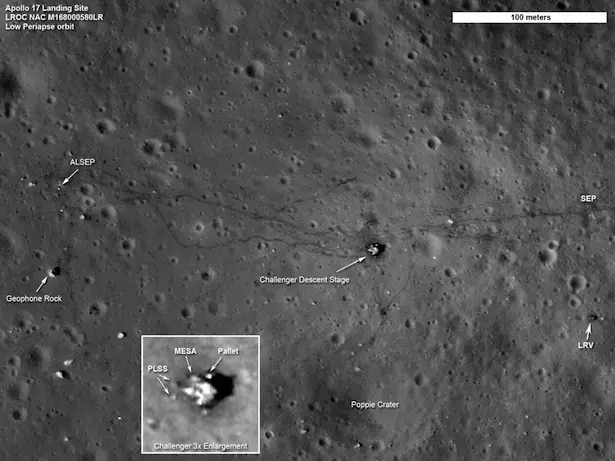
In the centre is the lunar module’s descent stage (“Challenger”), as well as the module’s experimental pallet, the ladder leading down to the lunar surface, and the life-support backpacks (PLSS) that the APOLLO 17 crew members Gene Cernan and Jack Schmitt jettisoned out of their ascent module to reduce take off weight just before leaving the lunar surface. In the photo you can clearly see the paths left by walking astronauts and wheeled tracks left by the Lunar Roving Vehicle (LRV).
The image was captured by NASA’s Lunar Reconnaissance Orbiter, some 13 to 15 miles above the moon’s surface. (NASA/GSFC/Arizona State University)
In addition to the material from the APOLLO missions the wreckage of two probes that had spent the past year orbiting the moon for NASA’s GRAIL mission lie on the surface of the moon. The reason the can be found there and not orbiting in deep space is they were deliberately crashed into the lunar surface.
Deliberate crashes like this are a normal means of bringing to a close unmanned lunar mission. This method is also used in unmanned mission to other planets in the Solar System

However the end results of this, inevitably, leaves debris strewn on the Moon and also on other planets across our solar system. It means that the moon, in particular, has over nearly 200,000kg of man made artefacts that will prove to be of great interest to future archaeologists.
In historical terms, the surface of the Moon preserves human footprints and artefacts that record the story of one of the greatest achievement in mankind’s history, that of the quest for the stars. The Lunar surface is an intact museum and heritage site that provides a unique setting for our early period of space travel.
Photos from the lunar probe show the wreckage of over 75 spacecraft – over 75 vehicles in are spread all over the lunar surface. However other items remain that are too small to see on photos These objects remain on the surface for a variety of reason including they had broken or fulfilled their mission, tools, human waste, flags marking the mission landing spot and items of personal artefacts left deliberately behind by the astronauts
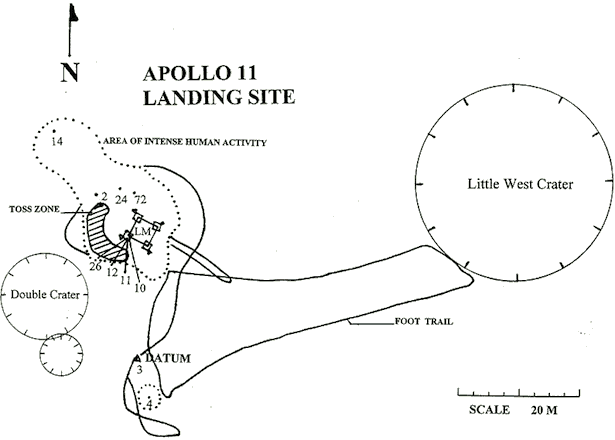
The first men on the Moon Buzz Aldrin and Neil Armstrong left more than 100 items on the Sea of Tranquility. The majority of the items were mundane including shovel, rakes, and one a plaque with the inscription “we came in peace for all mankind.”
With that in mind, here is a partial list of the items that future archaeologists might find if and when they visit the moon in the future.
- more than 70 spacecraft, including rovers, modules, and crashed orbiters
- 5 American flags
- 2 golf balls
- 12 pairs of boots
- TV cameras
- film magazines
- 96 bags of urine, feces, and vomit
- numerous Hasselbad cameras and accessories
- several improvised javelins
- various hammers, tongs, rakes, and shovels
- backpacks
- insulating blankets
- utility towels
- used wet wipes
- personal hygiene kits
- empty packages of space food
- a photograph of Apollo 16 astronaut Charles Duke’s family
- a feather from Baggin, the Air Force Academy’s mascot falcon, used to conduct Apollo 15’s famous “hammer-feather drop” experiment
- a small aluminum sculpture, a tribute to the American and Soviet “fallen astronauts” who died in the space race — left by the crew of
- Apollo 15
- a patch from the never-launched Apollo 1 mission, which ended prematurely when flames engulfed the command module during a 1967
- training exercise, killing three U.S. astronauts
- a small silicon disk bearing goodwill messages from 73 world leaders, and left on the moon by the crew of Apollo 11
- a silver pin, left by Apollo 12 astronaut Alan Bean
- a medal honoring Soviet cosmonauts Vladimir Komarov and Yuri Gagarin
- a cast golden olive branch left by the crew of Apollo 11
There is another object that lies on the Lunar Surface and that is an urn containing the ashes of Eugene Shoemaker, the famed planetary geologist. His lifelong ambition was to visit the moon.
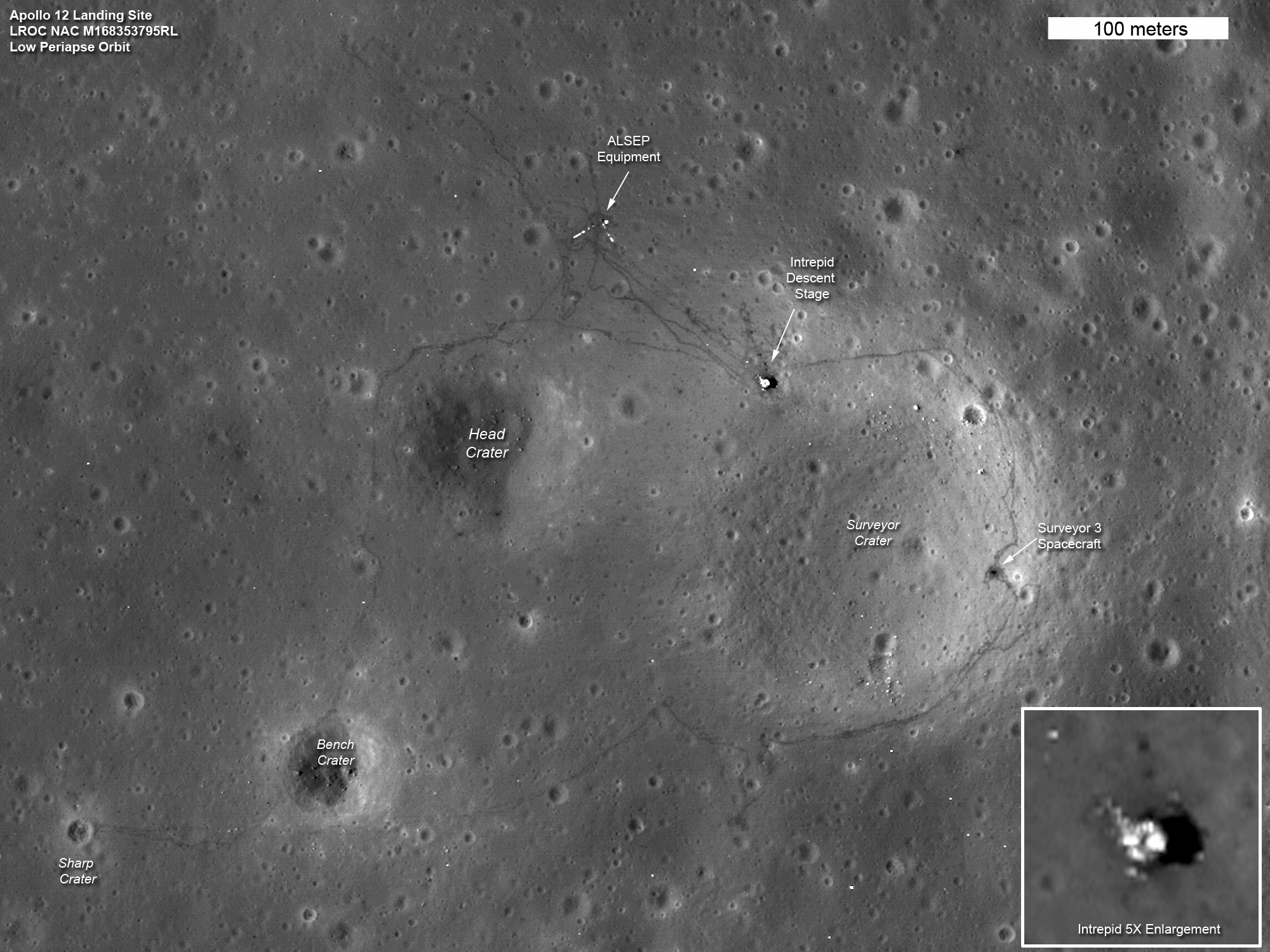
So who or what will protect this unique site from the looters, nighthawks and vandals of the future. Well strangely enough the organisation that is culprit for the vast majority of the debris on the Moon surface.
NASA has drafed guidelines to protect the Apollo 11 and Apollo 17 landing sites, listing them as off-limits, and including close proximity limits for ground-travel and no-fly zones to avoid spraying rocket exhaust or dust onto aging but historic equipment.
Robert Kelso, NASA’s director of lunar commercial services at Johnson Space Center in Houston, has taken a hard look at future revisits to the Apollo sites and how to protect U.S. government artifacts on the moon.
Kelso has carved out a set of guidelines intended to safeguard the historic and scientific value of more than three dozen “heritage sites” on the lunar surface.
The report, which was released on July 20, is titled “NASA’s Recommendations to Space-Faring Entities: How to Protect and Preserve the Historic and Scientific Value of U.S. Government Lunar Artifacts.”
A greater urgency for guidelines has been sparked by the Google Lunar X Prize’s offer of $20 million to any private team that lands a robotic rover on the moon’s surface. An additional $4 million has been offered for any team that snaps pictures of artifacts near or at the Apollo landing sites.
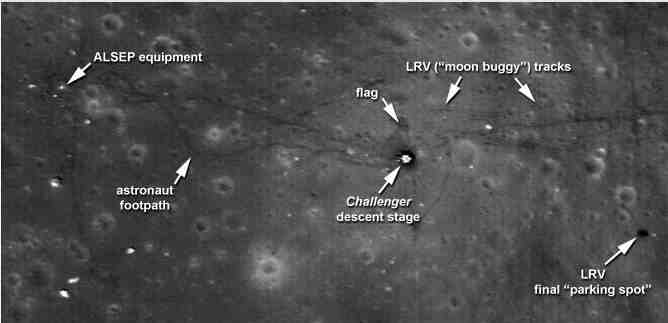
For Kelso, a key question is: “As the small commercial landers make preparations for possible visits to these historic sites, how do we protect these culturally significant sites from damage so that we can inspect them historically and scientifically?”
The recommendations listed by NASA are intended to apply to U.S. government artifacts on the lunar surface, such as:
- Apollo lunar surface landing and roving hardware;
- Unmanned lunar surface landing sites (e.g., Surveyor robotic landing sites) and impact sites, such as those of NASA’s Ranger spacecraft, as well as the Lunar Crater Observation and Sensing Satellite (LCROSS) that slammed into the moon in October 2009;
- U.S. government experiments left on the lunar surface, tools, equipment, miscellaneous moonwalking gear; and
- Specific indicators of U.S. human, human-robotic lunar presence, including footprints and rover tracks.
Beth O’Leary, an anthropology professor at New Mexico State University said that the NASA guidelines create a series of keep-out zones and boundaries around the historic artifacts and features at all Apollo sites. Apollo 11 and Apollo 17 are acknowledged as having special historical and cultural significance, she said.
Those two locales are treated as unique by prohibiting visits to any part of these sites, and all future visiting vehicles would remain beyond the “artifact boundaries” of each entire site. “This provides a robust zone of protection around these two sites,”
O’Leary said, “the need for protecting what it calls ‘witness plates’ or ‘lunar assets’ — those significant artifacts it created in the past that are now on the moon. This is a critical first step and many more have to follow, but for the first time NASA formally recognizes the heritage value of Apollo 11 and other extraordinary lunar sites.”
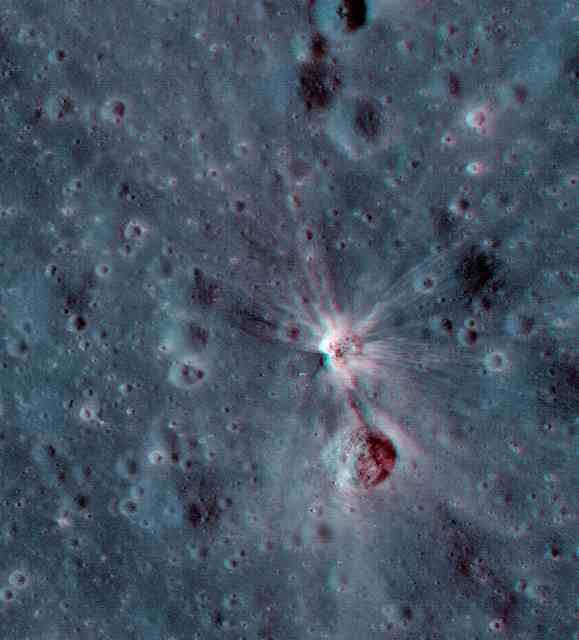
He continued “Importantly, it recognizes that future missions can disturb or change the earlier lunar sites in ways that scientific and historic information can be lost, It was time for a preservation strategy,”
Also, some of the sites are still active and continue to provide data — such as Apollo retro-reflectors used to measure the distance between the Earth and moon via laser ranging.
Hopefully the proposed strategy by NASA will insure the protection and preservation of this unique site of human heritage for future generation.
Contributing Source : NASA
About the author
Diarmaid is a national award wining archaeologist and a graduate from the University of Sussex (MA). He is currently undertaking PHD research on the origins and development of Grog tempered Roman pottery within the area of Kent and Sussex. Diarmaid has excavated extensively in the Middle East and advises government departments on the historical and cultural aspect of country in the region
HeritageDaily : Archaeology News : Archaeology Press Releases






